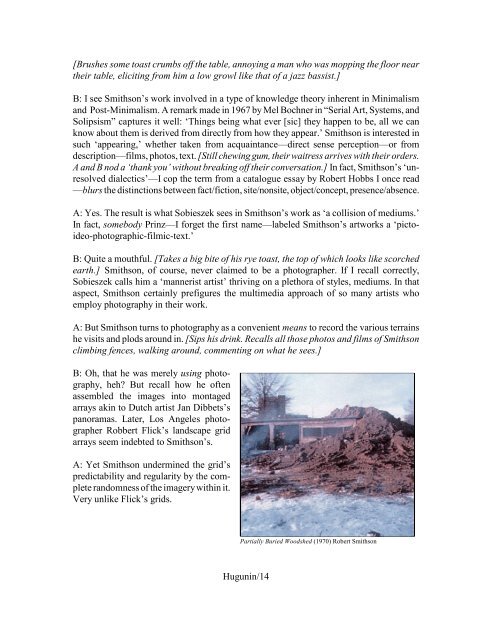It's Art, But Is It Photography? Robert Smithson's - Uturn.org
It's Art, But Is It Photography? Robert Smithson's - Uturn.org
It's Art, But Is It Photography? Robert Smithson's - Uturn.org
Create successful ePaper yourself
Turn your PDF publications into a flip-book with our unique Google optimized e-Paper software.
[Brushes some toast crumbs off the table, annoying a man who was mopping the floor near<br />
their table, eliciting from him a low growl like that of a jazz bassist.]<br />
B: I see Smithson’s work involved in a type of knowledge theory inherent in Minimalism<br />
and Post-Minimalism. A remark made in 1967 by Mel Bochner in “Serial <strong>Art</strong>, Systems, and<br />
Solipsism” captures it well: ‘Things being what ever [sic] they happen to be, all we can<br />
know about them is derived from directly from how they appear.’ Smithson is interested in<br />
such ‘appearing,’ whether taken from acquaintance—direct sense perception—or from<br />
description—films, photos, text. [Still chewing gum, their waitress arrives with their orders.<br />
A and B nod a ‘thank you’ without breaking off their conversation.] In fact, Smithson’s ‘unresolved<br />
dialectics’—I cop the term from a catalogue essay by <strong>Robert</strong> Hobbs I once read<br />
—blurs the distinctions between fact/fiction, site/nonsite, object/concept, presence/absence.<br />
A: Yes. The result is what Sobieszek sees in Smithson’s work as ‘a collision of mediums.’<br />
In fact, somebody Prinz—I f<strong>org</strong>et the first name—labeled Smithson’s artworks a ‘pictoideo-photographic-filmic-text.’<br />
B: Quite a mouthful. [Takes a big bite of his rye toast, the top of which looks like scorched<br />
earth.] Smithson, of course, never claimed to be a photographer. If I recall correctly,<br />
Sobieszek calls him a ‘mannerist artist’ thriving on a plethora of styles, mediums. In that<br />
aspect, Smithson certainly prefigures the multimedia approach of so many artists who<br />
employ photography in their work.<br />
A: <strong>But</strong> Smithson turns to photography as a convenient means to record the various terrains<br />
he visits and plods around in. [Sips his drink. Recalls all those photos and films of Smithson<br />
climbing fences, walking around, commenting on what he sees.]<br />
B: Oh, that he was merely using photography,<br />
heh? <strong>But</strong> recall how he often<br />
assembled the images into montaged<br />
arrays akin to Dutch artist Jan Dibbets’s<br />
panoramas. Later, Los Angeles photographer<br />
Robbert Flick’s landscape grid<br />
arrays seem indebted to Smithson’s.<br />
A: Yet Smithson undermined the grid’s<br />
predictability and regularity by the complete<br />
randomness of the imagery within it.<br />
Very unlike Flick’s grids.<br />
Partially Buried Woodshed (1970) <strong>Robert</strong> Smithson<br />
Hugunin/14


